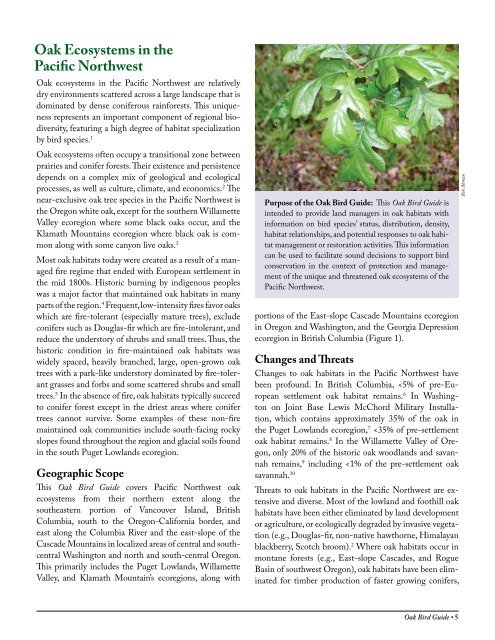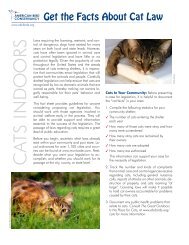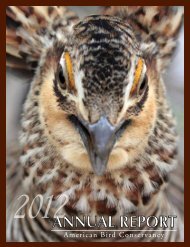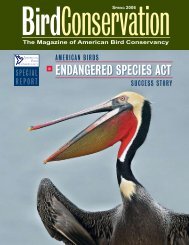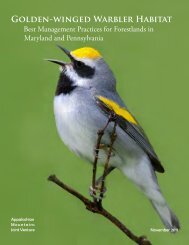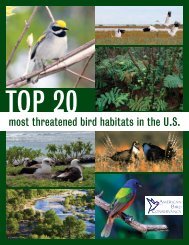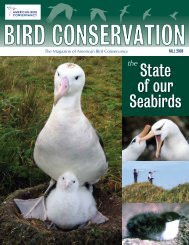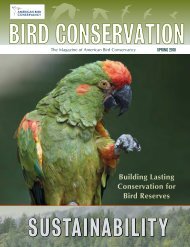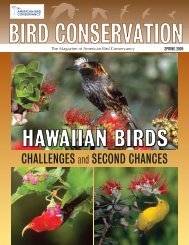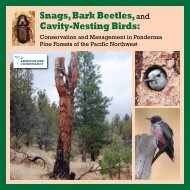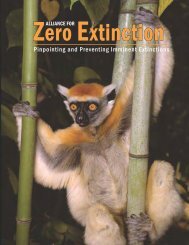Oak Ecosystems in the Pacific Northwest - American Bird Conservancy
Oak Ecosystems in the Pacific Northwest - American Bird Conservancy
Oak Ecosystems in the Pacific Northwest - American Bird Conservancy
Create successful ePaper yourself
Turn your PDF publications into a flip-book with our unique Google optimized e-Paper software.
<strong>Oak</strong> <strong>Ecosystems</strong> <strong>in</strong> <strong>the</strong><br />
<strong>Pacific</strong> <strong>Northwest</strong><br />
<strong>Oak</strong> ecosystems <strong>in</strong> <strong>the</strong> <strong>Pacific</strong> <strong>Northwest</strong> are relatively<br />
dry environments scattered across a large landscape that is<br />
dom<strong>in</strong>ated by dense coniferous ra<strong>in</strong>forests. This uniqueness<br />
represents an important component of regional biodiversity,<br />
featur<strong>in</strong>g a high degree of habitat specialization<br />
by bird species. 1<br />
<strong>Oak</strong> ecosystems often occupy a transitional zone between<br />
prairies and conifer forests. Their existence and persistence<br />
depends on a complex mix of geological and ecological<br />
processes, as well as culture, climate, and economics. 2 The<br />
near-exclusive oak tree species <strong>in</strong> <strong>the</strong> <strong>Pacific</strong> <strong>Northwest</strong> is<br />
<strong>the</strong> Oregon white oak, except for <strong>the</strong> sou<strong>the</strong>rn Willamette<br />
Valley ecoregion where some black oaks occur, and <strong>the</strong><br />
Klamath Mounta<strong>in</strong>s ecoregion where black oak is common<br />
along with some canyon live oaks. 3<br />
Most oak habitats today were created as a result of a managed<br />
fire regime that ended with European settlement <strong>in</strong><br />
<strong>the</strong> mid 1800s. Historic burn<strong>in</strong>g by <strong>in</strong>digenous peoples<br />
was a major factor that ma<strong>in</strong>ta<strong>in</strong>ed oak habitats <strong>in</strong> many<br />
parts of <strong>the</strong> region. 4 Frequent, low-<strong>in</strong>tensity fires favor oaks<br />
which are fire-tolerant (especially mature trees), exclude<br />
conifers such as Douglas-fir which are fire-<strong>in</strong>tolerant, and<br />
reduce <strong>the</strong> understory of shrubs and small trees. Thus, <strong>the</strong><br />
historic condition <strong>in</strong> fire-ma<strong>in</strong>ta<strong>in</strong>ed oak habitats was<br />
widely spaced, heavily branched, large, open-grown oak<br />
trees with a park-like understory dom<strong>in</strong>ated by fire-tolerant<br />
grasses and forbs and some scattered shrubs and small<br />
trees. 5 In <strong>the</strong> absence of fire, oak habitats typically succeed<br />
to conifer forest except <strong>in</strong> <strong>the</strong> driest areas where conifer<br />
trees cannot survive. Some examples of <strong>the</strong>se non-fire<br />
ma<strong>in</strong>ta<strong>in</strong>ed oak communities <strong>in</strong>clude south-fac<strong>in</strong>g rocky<br />
slopes found throughout <strong>the</strong> region and glacial soils found<br />
<strong>in</strong> <strong>the</strong> south Puget Lowlands ecoregion.<br />
Geographic Scope<br />
This <strong>Oak</strong> <strong>Bird</strong> Guide covers <strong>Pacific</strong> <strong>Northwest</strong> oak<br />
ecosystems from <strong>the</strong>ir nor<strong>the</strong>rn extent along <strong>the</strong><br />
sou<strong>the</strong>astern portion of Vancouver Island, British<br />
Columbia, south to <strong>the</strong> Oregon-California border, and<br />
east along <strong>the</strong> Columbia River and <strong>the</strong> east-slope of <strong>the</strong><br />
Cascade Mounta<strong>in</strong>s <strong>in</strong> localized areas of central and southcentral<br />
Wash<strong>in</strong>gton and north and south-central Oregon.<br />
This primarily <strong>in</strong>cludes <strong>the</strong> Puget Lowlands, Willamette<br />
Valley, and Klamath Mounta<strong>in</strong>’s ecoregions, along with<br />
Purpose of <strong>the</strong> <strong>Oak</strong> <strong>Bird</strong> Guide: This <strong>Oak</strong> <strong>Bird</strong> Guide is<br />
<strong>in</strong>tended to provide land managers <strong>in</strong> oak habitats with<br />
<strong>in</strong>formation on bird species’ status, distribution, density,<br />
habitat relationships, and potential responses to oak habitat<br />
management or restoration activities. This <strong>in</strong>formation<br />
can be used to facilitate sound decisions to support bird<br />
conservation <strong>in</strong> <strong>the</strong> context of protection and management<br />
of <strong>the</strong> unique and threatened oak ecosystems of <strong>the</strong><br />
<strong>Pacific</strong> <strong>Northwest</strong>.<br />
portions of <strong>the</strong> East-slope Cascade Mounta<strong>in</strong>s ecoregion<br />
<strong>in</strong> Oregon and Wash<strong>in</strong>gton, and <strong>the</strong> Georgia Depression<br />
ecoregion <strong>in</strong> British Columbia (Figure 1).<br />
Changes and Threats<br />
Changes to oak habitats <strong>in</strong> <strong>the</strong> <strong>Pacific</strong> <strong>Northwest</strong> have<br />
been profound. In British Columbia,


